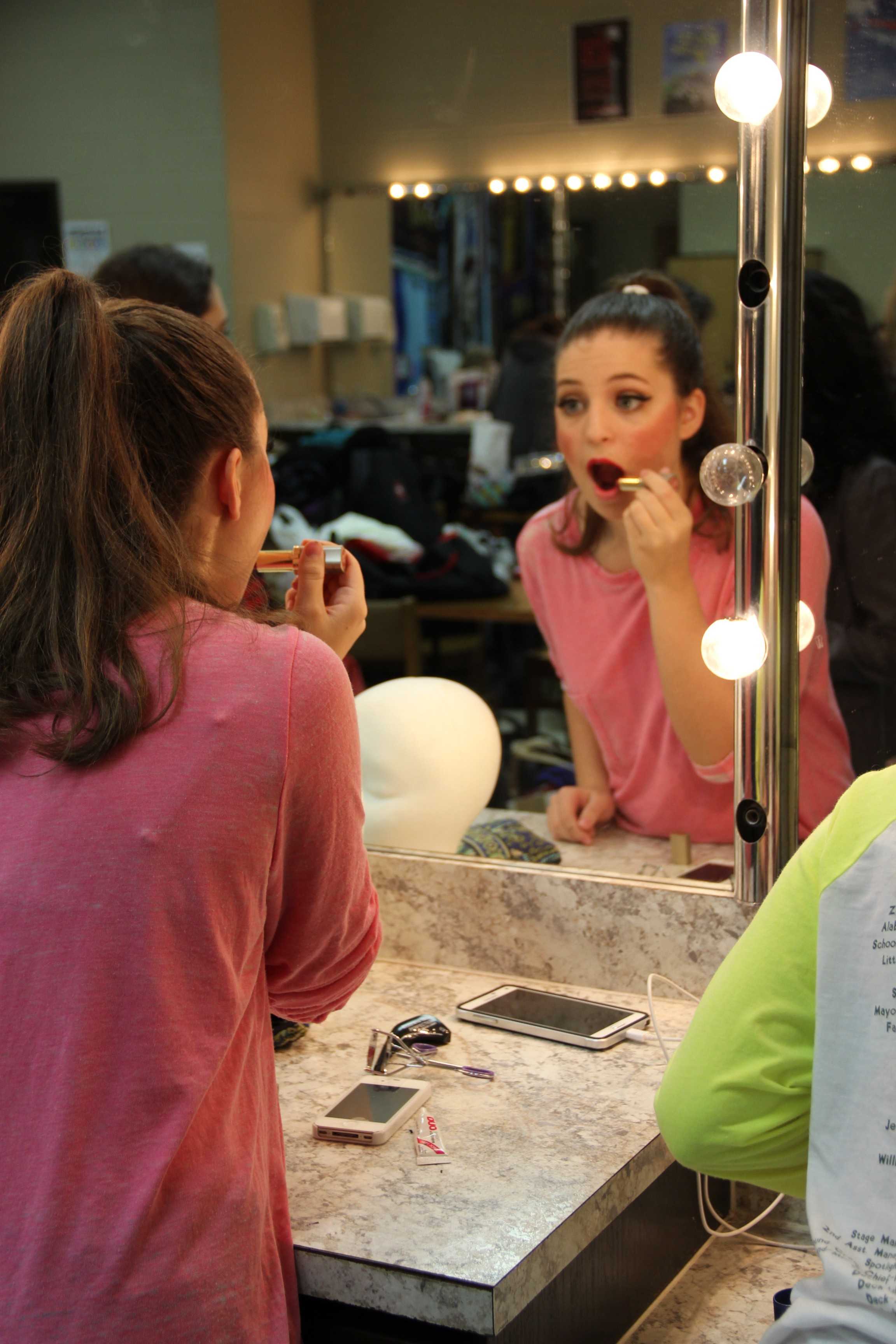Big Fish: The show behind the stage
Junior Ty Dalrymple, 11 year old Coppell Middle School West student Drew Chappell and the ensemble receive applause after the end of “Be the Hero”, the opening number of “Big Fish” on Oct. 30 at Coppell High School. Dalrymple played Edward Bloom and Chappell played Young Will Bloom, his son. Photo by Maggie Theel.
November 6, 2015
You saw the curtains unearth a story. You saw them ripple away as real people brought a fictional tale to life, and you heard the music that rose to the beat of falling lights. You were riveted when Edward Bloom, the hero of the play Big Fish, blew a kaleidoscopic tempest of fantastical stories across the stage, and you were amiss of what was real and what was not.
You were wary and in love with the man and the life he claimed to live. But most of all, you were awed by the actors, actresses and ensemble who transformed the stage from a few mics and an empty auditorium, into a lifetime of wonders and applause that echoed.
Here’s what you missed.
Act One
Scene 1: Before
Enter Narrator, Meha Srivastav (reporting the play), into bustling Green room, behind and away from stage.
Steps into world of theater, a little unsure. Takes in illuminated room that prances into the flashing glory of Broadway. Skirts the aligned benches and nears the mirrored walls, laden with the reflections of a buzzing cast, applying and fixing make up. Yellow bulbs like from a celebrity’s private room line the mirrors, below which lie counters scattered hectically with all kinds of makeup, hairspray and accessories for preparation.
The people of the play are everywhere- splayed on couches, sitting at the benches, digging deep into the cheeks that need more rouge. Above all, they are alive. They tingle loudly with chatter and ravings about anything, the atmosphere is relaxed and pulsating.
Walks towards some of the actresses/ensemble [junior Evalyn Clark and sophomore Macy McCready] in front of the mirror, after introducing herself, interviews them.

So how long have you been practicing for this?
Evalyn: Eight weeks .The auditions were on the second and third days of school.
And how were your past performances?
Evalyn: They were actually pretty good. We were really nervous going into the show, but after a while, we just got used to it, and it’s what we love doing. I can’t stop smiling.
Singing shoots from rest. Actresses pause to fix makeup.
So what’s your favorite part of the show?
Macy: I really like the whole story of the show, its plot. We have really cool characters, like a witch and a giant. It’s just fun seeing what everyone does.
How does it feel, after the play is done, when you all bow in front of the audience and everything comes to an end?
Macy: The applause at the end, I feel like it’s the moment we all live for. You’ve been putting so much effort towards the show, so when the audience claps, it’s a sense of relief.
Do you ever feel like you become the character?
Singing balloons and exalts in background
Macy: I think that’s what the show is, to become the character, so you can pull it off and make it believable; the whole point of theatre is becoming a different character and seeing the world with their perspective.
I then wander around to explore more of what happens before the play begins. I meet senior Claire Police, stage manager, champion of the entire backstage crew in black, who takes her behind the curtains to see the machinery that whirs everything from before the beginning to after the end of the play.
Claire: So this is Backstage.
Enter both into dark, rectangular area behind curtains. A miscellany of props for the play run by the sides- these range from a hospital bed to a rainbow of hats to flowers to tables right out of a living room.
Claire: These are our set pieces (points to array of chairs, tables etc. ), and well, backstage is this sort of organized disaster, because we have to fit dozens of set pieces in this tiny little space, so everything is put where we can get it. So it’s pretty crazy.
Leads me into confluence of backstage and sidestage- here lie more technical parts of the theatrical equipment.
Claire: Here’s the loading dock, where we store stuff without using it. And if you look up, you can see the balloon drop.
(Gestures high up above the stage, to a cocooned bundle of balloons.)
The wooden panels (these are large standing boards attached to the side of the stage) move across the stage or just hang. Vertical bars run along the side walls, and a ladder rises to a ramp many feet up against the wall.
Here the crew can go up and adjust the curtains by pulling a rope up or down. The ‘quick-change hall’- is here right behind the stage. If it’s one of those super-fast changes we just do it in the wings. It’s incredibly stressful.
Background: Or you can layer it like I do. I just wear a whole outfit under another one!
Claire: So that’s our backstage. It’s crazy during the show, cause there’s a lot of us- there’s 40 in the cast, 15 people in the crew. And there’s all the set costumes and props here. We have people wait in the green room though, so they’re out of the way. It’s insane, but it’s a great insane. I wouldn’t trade it for the world.
(I walk back to Green Room, where I speaks with more of the cast. Some say they are “nervous and hyped”, others “focused”. Afterwards, I meet Ty Dalrymple, a junior, who plays Edward Bloom, the outlandish hero of the show.)
How are you feeling right now?
Ty: A little nervous, but it’s always exciting.
Tell me about the moment when you realized your passion for drama.
Ty: It was in eighth grade, when I just knew I wanted to do it. I can’t really relate it to anything, but if anything it’s like the feeling when you’re at the top and about to go down a rollercoaster…it’s so liberating.
It’s a musical – how are you able to manage that, having to sing and act your best at the same time?
Ty: I try to do my best; you have to mix them both. But it’s very challenging to balance, because there are over 300 lines and 12 songs to remember.
(I speak to the ensemble and tech team and asks them more about the difficulties of theatre.)
Ensemble: There’s really no break. And it can get really hard to manage; there’s one scene in which I have to get a cannon away from the stage while pulling off a G sharp.
Tech Team: Yeah, it can get hard for us. Once, during Tech Week, the power went and the ceiling started leaking. But you just think it’s going to be better next time. And well, there’s a reason for the saying ‘The show must go on’.
(Actors are called to places, show begins.)
Scene 2: During
It is the intermission, the audience are out to fill their stomachs, but for the cast it is by no means a break. They set up the props and make sure everything is ready to go backstage. It’s mostly a ‘crunch-time’ for the entire cast, and barely before the curtains know it, the act has ensued.
The crew members not required by the show at present relax in the green room, where a TV fills them in on which scene is rolling- but they have it all by heart. They can be heard saying, “You know every line, even from the green room.” Some chatter, others listen to music haphazardly or prepare for upcoming scenes.
Scene 3: After
Two and a half hours lived, the auditorium floods open a gushing crowd out into the hall. Stage characters are shed by the thespians as they flock to congratulations from real friends and family. A sense of relief and joy eases away scrupulous make up and second layer costumes, and the place is abound with chatter and accomplishment.
I meet Jack Dalrymple, who played the son of his real twin, Ty Dalrymple, in the show.
Jack: I feel accomplished, and I’m not going to have this opportunity again because one of us usually gets the part, the other one gets shoved off. It was such a good show for me because we have that connection as twins, and there’s no blood thicker than that. To be able to do that on stage together, it was awesome.
I speak next to parents of a cast member.
Parent: It was a very unique show, and it was very visual. We loved it. It was a touching and such a sweet story. And this was also the fifth time we were seeing it.
I exit the scene, hands still clasped in an echo of applause.
CURTAINS FALL










